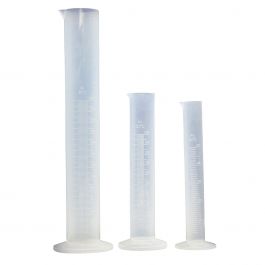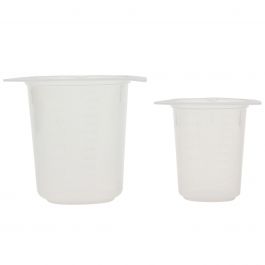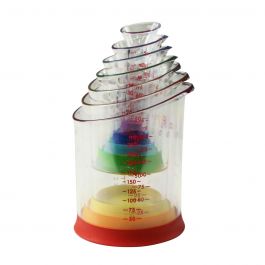Navigation
Install the app
How to install the app on iOS
Follow along with the video below to see how to install our site as a web app on your home screen.
Note: This feature may not be available in some browsers.
More options
You are using an out of date browser. It may not display this or other websites correctly.
You should upgrade or use an alternative browser.
You should upgrade or use an alternative browser.
Calibrating
- Thread starter LOVEROCK
- Start date
- Tagged users None
Users Who Are Viewing This Thread (Total: 1, Members: 0, Guests: 1)
- Joined
- Aug 21, 2018
- Messages
- 42
- Reaction score
- 18
10ml cylinder for speed 0 and 50ml cylinder for speed 3. But I have changed to use kitchen scale, it is more easy to read and you can also do 5 calibrations in a row and take average, this will give a better calibration.
Sounds like a good idea. Care to describe the procedure? What factor do you use? Is it variable with salinity levels?10ml cylinder for speed 0 and 50ml cylinder for speed 3. But I have changed to use kitchen scale, it is more easy to read and you can also do 5 calibrations in a row and take average, this will give a better calibration.
Personally I have all 3. They are good to have around not just for calibration but for the addition of additives.What size gradated cylinders are ideal to have , since the KH director (dosing) has 3 different speeds from what i have been hearing

High Quality Graduated Cylinder
Our high quality graduated cylinders have 1 mL graduations that allow for more accurate measuring when dosing. Available in three sizes: 50 mL Graduated Cylinder 100 mL Graduated Cylinder 250 mL Graduated Cylinder
I also have a 250ml, 500ml, and 1,000ml beakers.

Graduated Measuring Cup
Reef Safe tripour measuring cups are great for metering any type of liquid. Each cup has graduated markings up the side allowing you to see how much liquid volume you have in your cup. Measurements are available in milliliters and fluid ounces. High quality graduated measuring cups with a...

7-Piece Liquid Measuring Beaker Set Good Grips
Make small liquid measurements easy with this 7 Piece Mini Measuring Beaker Set from OXO Good Grips. Set includes 1 tsp, 1 tbsp, 1 oz, 2 oz, 1/2 cup, 2/3 cup and 1 cup Filling and pouring made easy with funnel shape and spout Rubber bottom helps reduce slips Easy to read measurement markings...
- Joined
- Aug 21, 2018
- Messages
- 42
- Reaction score
- 18
Sounds like a good idea. Care to describe the procedure? What factor do you use? Is it variable with salinity levels?
I used normal tap water to do the calibration. And also used a separate set of tubing, that are just long enough to do the job.
The procedure is simple, just do 5 consecutive calibrations (or more if the dispensed amount fluctuated a lot), with the output tube dispense directly into a container placed on a tared kitchen scale. Weight the total amount of water dispensed and divided by 5. After the calibration is done and saved, I will also do a manual dosing to see if the dispensed amount is correct.
Understand, thanks. However just to be clear, (I need to know the math behind it) you are using the density of RO water as the factor, and the average of the 5 test multiplied by that factor is how many ml you use as your calibration value.I used normal tap water to do the calibration. And also used a separate set of tubing, that are just long enough to do the job.
The procedure is simple, just do 5 consecutive calibrations (or more if the dispensed amount fluctuated a lot), with the output tube dispense directly into a container placed on a tared kitchen scale. Weight the total amount of water dispensed and divided by 5. After the calibration is done and saved, I will also do a manual dosing to see if the dispensed amount is correct.
Using the chart below in this example.
5 tests yields 60ml of volume. Average per test would be 12ml. Using 25*C (77F) RO water, the result would be 11.96ml. That would be your calibration value. Now I know that you can use a factor of 1 (1:1 ratio) and the resulting value would be 12ml (close enough), but there might be cases where you can't use the 1:1 ratio and this could skew the calibration value to much.
I do the same but I use the actual fluid and exactly the tubes that I going to use. In the right lengths.I used normal tap water to do the calibration. And also used a separate set of tubing, that are just long enough to do the job.
The procedure is simple, just do 5 consecutive calibrations (or more if the dispensed amount fluctuated a lot), with the output tube dispense directly into a container placed on a tared kitchen scale. Weight the total amount of water dispensed and divided by 5. After the calibration is done and saved, I will also do a manual dosing to see if the dispensed amount is correct.
Sincerely Lasse
From RHF DIY alkalinty test he states :
"There is a minor correction you should make when using a scale to measure the volume of seawater since 1 mL of seawater weighs a bit more than 1 gram. It will be close enough for any marine sample if you divide the weight you measure by 1.026 to get the volume. So 1,026 grams of aquarium water is 1,000 mL or 1 L. Likewise, aim for 256.5 grams for 250 mL or 513 grams for 500 mL."
"There is a minor correction you should make when using a scale to measure the volume of seawater since 1 mL of seawater weighs a bit more than 1 gram. It will be close enough for any marine sample if you divide the weight you measure by 1.026 to get the volume. So 1,026 grams of aquarium water is 1,000 mL or 1 L. Likewise, aim for 256.5 grams for 250 mL or 513 grams for 500 mL."
Similar threads
- Replies
- 1
- Views
- 213
- Replies
- 3
- Views
- 190
- Replies
- 2
- Views
- 332
- Replies
- 0
- Views
- 99
- Replies
- 17
- Views
- 594









